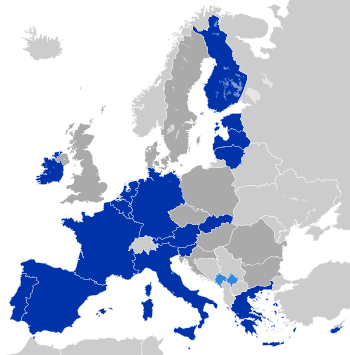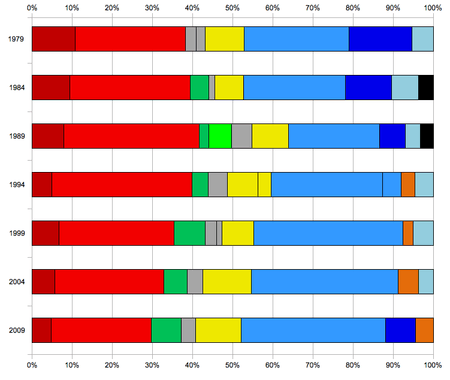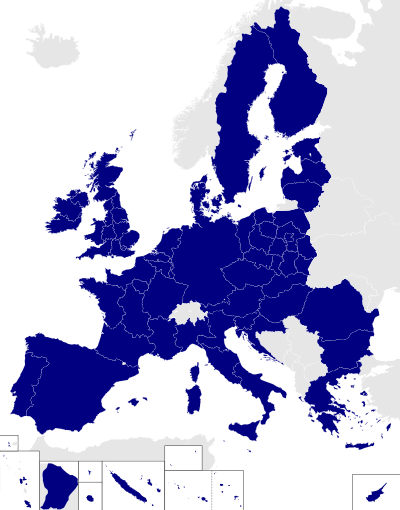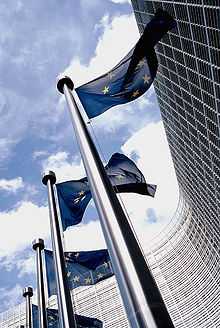ECHO (European Commission)

The European Commission's Humanitarian Aid and Civil Protection department (ECHO), formerly known as the European Community Humanitarian Aid Office, is the European Commission's department for overseas humanitarian aid and for civil protection.
In 2013 it provided €1.35 billion for emergency relief.[1] The European Union has been the second largest donor of humanitarian assistance since 2000. Together with its Member States, it is the world's biggest donor of humanitarian aid, providing over 50% of the total humanitarian aid in 2009.[2] ECHO-funded projects affect over 120 million people in 90 countries annually.
For its humanitarian interventions, ECHO does not implement assistance programmes itself; but funds operations through a wide range of around 200 partners (NGOs, UN agencies, and international organisations such as the Red Cross/Red Crescent Movement).[3] In 2013, ECHO had 44 field offices in 39 countries, with 149 international humanitarian experts and 315 national staff members. The field offices provide up-to-date analysis of existing and forecasted needs in a given country or region, contribute to the development of intervention strategies and policy development, provide technical support to ECHO funded operations, and ensure adequate monitoring of these interventions and facilitate donor's coordination at field level.[4]
In addition to providing funding to humanitarian aid, ECHO is also in charge of the EU Civil Protection Mechanism. Established in 2001, the Mechanism fosters cooperation among national civil protection authorities across Europe. Currently 31 countries are members of the Mechanism; all 28 EU Member States in addition to Iceland, Norway, and the Republic of Macedonia. The Mechanism was set up to enable coordinated assistance from the participating states to victims of natural and man-made disasters in Europe and elsewhere.
After the EU was awarded the Nobel Peace Prize in 2012, the Barroso Commission accepted the prize money on behalf of the EU and allocated it to a new initiative called Children of Peace. Approximately €2 million was set aside for the Children of Peace projects in 2013. It was increased to €4 million in 2014.[5]
History
| European Union |
 This article is part of a series on the |
Policies and issues
|
Elections
|
The European Community Humanitarian Aid Office (ECHO) was established in 1992 by the Second Delors Commission. Funding from the office affects over 120 million people in 90 countries annually. It spends €800 million a year of its initial budget on humanitarian projects through its over 200 partners (such as the Red Cross, Relief NGOs and UN agencies).[6] It claims a key focus is to make EU aid more effective and humanitarian.[7] With the European Community being abolished in 2009, the office began to be known as the Humanitarian Aid and Civil Protection department of the European Commission or European Union, but kept its ECHO abbreviation.
A special Eurobarometer survey on humanitarian aid conducted in 2010 reveals the high sense of solidarity among European citizens towards victims of conflict and natural disasters outside their borders, with eight out of 10 citizens thinking that "it is important that the EU funds humanitarian aid outside its borders". However, fewer than two out of 10 European citizens spontaneously name the EU, the European Commission and/or ECHO as an actor funding humanitarian aid.[8]
Mandate and Principles
ECHO's mandate is to provide emergency assistance and relief (in the form of goods and services) to victims of conflict and natural or man-made disasters outside the EU. Its mandate also extends to disaster prevention and post-crisis operations.
European humanitarian aid is based on the principles of humanity and solidarity therefore its implementation depends on the application of international law, and in particular international humanitarian law, and on the fundamental principles of impartiality, non-discrimination and neutrality. ECHO’s humanitarian actions are based on compliance with international law and the humanitarian principles of humanity, neutrality, impartiality, and independence.Its implementation therefore depends on the application of international humanitarian law (IHL).[9]
Humanity means that human suffering must be addressed wherever it is found, with particular attention to the most vulnerable; neutrality means that humanitarian aid must not favour any side in an armed conflict or other dispute; impartiality means that humanitarian aid must be provided solely on the basis of need, without discrimination; and independence means the autonomy of humanitarian objectives from political, economic, military or other objectives.
In 2007, at the initiative of Commissioner Louis Michel, the European Commission adopted a "European Consensus on Humanitarian Aid" to constitute the first European political text of reference on humanitarian aid.[10] NGOs participated actively to the drafting of the European Consensus and it can be considered "the most comprehensive text and the nearest common position to NGOs".[11] The European Consensus reaffirms the humanitarian principles of humanity, impartiality and independence. It also stipulates "humanitarian aid is not a management tool for crises management".
Although the European Consensus on Humanitarian Aid was welcomed as a positive strong signal,[12] some NGOs expressed the wish that the success of the European Consensus on Humanitarian Aid should be enhanced humanitarian response at field level and not merely enhanced rhetoric in Brussels. Amongst others, several NGOs called on the European Union to use its political influence to support humanitarian aid based on the mere principles of neutrality and impartiality and not on security agendas.[13] In 2012 ECHO developed the first revision of the Consensus since its establishment, highlighting a need for stronger partnerships through quality selection of partners and ensuring enhanced accountability towards citizens and stakeholders.[14]
The EU-funded, Partnership for Peace, aims to "strengthen the capacity for conflict resistance and empower marginalized parties as well to build trust between Israelis and Arabs by increasing regional cooperation."[15] In response to this, the Palestinian Non-Governmental Organizations' Network, a body representing 135 NGOs in the West Bank and Gaza Strip, condemned the demand for collaboration between Palestinian NGOs and Israeli NGOs, saying it was "an attempt to involve civil society organizations in nationally unacceptable normalization with the occupation and its institutions, giving the impression that normal relations exist between the occupation and the people living under occupation."[16]
In 2012, ECHO and other donors worked with the Inter-Agency Standing Committee (IASC) to create the Transformative Agenda. Principles of humanitarian leadership, accountability and coordination were agreed upon to improve the rapidity, efficiency and effectiveness of humanitarian response. Additionally, civil protection was adopted as a part of ECHO's mandate to ensure better cooperation and protection during disaster among third and regional countries and international organisations.
Legislation
Since the Lisbon Treaty came into force, the EU's humanitarian aid action is ruled by Article 214 of the Treaty of the Functioning of the European Union.[17] Humanitarian aid is a shared parallel competency: this means that the EU conducts an autonomous policy, which neither prevents the Member States from exercising their competences nor makes the EU's policy merely “complementary” to those of the Member States.[18]
Until then, humanitarian aid was based, by default, on Article 179 of the EC Treaty (development policy). It used to be part of the Commissioner for Development's portfolio, first Louis Michel and then Karel De Gucht during the first Barroso Commission. The Lisbon Treaty introduced, for the first time, humanitarian aid as a policy in its own right in the EC Treaty. Since 1 November 2014, humanitarian aid is managed by a dedicated Commissioner, Christos Stylianides.
As defined in article 214 TFEU, the EU's operations in the field of humanitarian aid are intended to provide ad hoc assistance and relief for people in third countries who are victims of natural or man-made disasters. Article 214 TFEU also reiterates the principles of humanitarian aid, these being respect for international law and the principles of impartiality, neutrality and independence.[19]
The Lisbon Treaty also introduces a European Voluntary Humanitarian Aid Corps (Article 214 of the Treaty on the functioning of the EU), which allows Europeans wishing to be directly involved in humanitarian action to join.
EU Aid Volunteers
The European Commission set out an initiative to create more than 18,000 positions for EU citizens to volunteer worldwide in humanitarian situations between 2014-2020. The initiative trains volunteers together in a European training programme before deployment with certified humanitarian organisations.[20] Financial support, focusing on building up resilience and civil protection capacity, was agreed for five pilot projects involving approximately 150 volunteers in 2012.
The European Parliament (EP) voted in favour of the initiative in February 2014. Volunteer positions include deployment to EU-funded humanitarian operations around the world, working at humanitarian organisations inside the EU, or assisting operations online from home.[21]
NGOs taking part go through a certification process in order to ensure they comply with European standards for managing volunteers.
Budget
In 2013, ECHO's aid budget amounted to less than one percent of the entire EU budget. In addition, the European Commission used their Emergency aid reserve to respond to crises and unexpected disasters. The budget with reserve funds totaled €1.35 billion in 2013. As for humanitarian aid, ECHO provided humanitarian assistance to about 124 million people in 90 non-EU countries, of which 39 were designated as being in situation of crisis. As for civil protection, the civil protection mechanism was activated 36 times in 2013 for crises inside and outside the EU.
The largest share of funding is for food and nutrition (40%). Shelter (19%), the health and medical sector (including psychosocial support) (13%), Water and Sanitation (13%) and Protection (7%) are the other main areas of activities. ECHO allocated 3% of the 2013 budget to Disaster preparedness, decreased from 2012. Civil Protection represented 2% of the budget.
In 2013, 40% of the budget went to Africa and 18% to Asia, Latin America, the Caribbean and Pacific, and 32% to the Middle East and Mediterranean.[22]
Some charities have claimed European governments have inflated the amount they have spent on aid by incorrectly including money spent on debt relief, foreign students and refugees. Under the de-inflated figures, the Union did not reach its internal aid target in 2006.[23]
Again in 2010, the EU did not reach its internal aid target: figures reveal that member states failed to hit the 0.56% collective target of gross national income for aid last year, a figure set in 2005. The target for 2015 is 0.7%.[24] In 2010, Netherlands (0.81%), Denmark (0.9%), Sweden (0.97%), Luxembourg (1.09%) and Norway (1.1%) were the only countries in the world that have met the ODA target of 0.7 of GNI.[25] There are no new reports available to evaluate aid targets after 2010.
However, development aid reached an historic high in 2010. Together with the aid given by member states individually, the EU is the largest aid donor in the world.[26] Of the €9.8 billion of humanitarian aid provided worldwide in 2010, some 41% was delivered by the EU.[27]
The adopted budget for 2014 has nearly €1 billion in commitments for humanitarian aid and civil protection.[28]
Strategy
The European Commission has a mandate to save and preserve life in emergency and immediate post-emergency situations, whether these are natural or man-made. Following these principles, the Commission is committed to preparing every year a Strategy document in order to co-ordinate and to programme activities efficiently and in an appropriate manner adopting an impartial approach based on needs.
In 2013, ECHO focused its humanitarian aid in nearly 90 countries. It identified the five largest humanitarian operations as the Sahel region of West Africa, including further response to the conflict in Mali (€82 million), Sudan and South Sudan (€80 million), the Democratic Republic of Congo (€54 million), Pakistan (€42 million) and Somalia (€40 million). 40% of the European Commission humanitarian assistance went to Sub-Saharan Africa.[29]
The reserve budget was utilised in order to respond to major humanitarian crises in Syria, Mali, the Sahel, South Sudan, Democratic Republic of the Congo, Myanmar, and the Philippines. ECHO also funds forgotten crises, such as in Bangladesh, Colombia, Yemen, Algeria, Pakistan, and Myanmar.
Reform
The former commissioner for aid, Louis Michel, had called for aid to be delivered more rapidly, to greater effect and on humanitarian principles.[26]
The appointment of a new commissioner with a portfolio for International cooperation, humanitarian aid and crisis response corresponds to articles 214 and 196 of the Treaty of Lisbon where Humanitarian aid and Civil Protection play a sustainable role. ECHO's official name was changed to Directorate-General for Humanitarian Aid and Civil Protection. The transformation of ECHO and the movement of the Civil Protection unit from DG Environment to DG ECHO is a step forward for better cooperation and decision making in a field where rapid reaction is lifesaving.
Clare Short, former British International Development Secretary said the European Commission ran ‘the worst development agency in the world’ and branded its operations ‘an outrage and a disgrace’.[30] Since 2012, the Commission developed an action plan and guidelines on resilience and linking between relief, rehabilitation and development (LRRD).[31]
The Commission passed new legislation in 2013 on the EU Civil Protection Mechanism which provides better coordination and support to improve effectiveness of prevention, preparation, and response systems during disasters. The legislation establishes a voluntary pool of pre-committed response capacities and materials, a training network for first responders, and a new approach for disaster risk management from 31 participating states.[32]
The EU Civil Protection Mechanism also established the opening of the new Emergency Response Coordination Centre (ERCC), a civil protection 'hub' for monitoring disasters and enhancing preparedness and resilience of disaster-prone countries. The most recent use of the Civil Protection mechanism occurred during flooding in Bosnia Herzegovina and Serbia.[33]
European Parliament Report
The Committee on Development (CD) of the EP commissioned the Overseas Development Institute to undertake a project on the effectiveness of international development assistance from the European Commission in 2010.[34] The project focused on the cases of Cambodia, Mozambique and Peru. The findings and policy suggested can be summarized as follows:[34]
- Harmonisation and alignment (H&A) is crucial for state capacity and should be expanded from sharing and spreading information to increasing joint activities in the short-term.
- Donor harmonisation efforts need to be scaled up to include agreements on joint technical assistance and the streamlining of systems and procedures
- Extremely fragmented aid systems impose unreasonably high transaction costs on the government, drains valuable resources, and fundamentally weakens state capacity.
- EC procedures and structures remain highly complicated and bureaucratic.
- Much of the success or failure of cooperation depends on individual interactions, specific innovators and appropriate staffing levels to carry out the tasks at hand, but the costs are also quite high.
- Country Strategy Papers could improve aid effectiveness — but their quality is uneven.
- Relations between HQ and delegations needs to be improved.
See also
- Office for the Coordination of Humanitarian Affairs (UN)
- Emergency management
References
- ↑ ECHO Humanitarian Aid Factsheet 2013
- ↑ Global Humanitarian Assistance website
- ↑ European Parlement Factsheet on the European Union: Humanitarian Aid
- ↑ ECHO Field Network. ECHO, retrieved 29-07-14.
- ↑ EU dedicates its Nobel Peace Prize to Education projects for Children in Conflict. Retrieved 27-06-14.
- ↑ ECHO Annual Report 2012
- ↑ "Humanitarian aid and the European Union". Europa (web portal). Retrieved 2007-09-23.
- ↑ Eurobarometer survey on humanitarian aid: Europeans care – and endorse the Commission's mandate, European Commission. 2010-08-04. Retrieved 2012-01-13
- ↑ Summaries of the EU legislation
- ↑ Rapport sur la mise en oeuvre du consensus européen sur l'aide humanitaire, European Parliament, Retrieved 2012-01-16
- ↑ Pierre Salignon, "L'Europe humanitaire en question(s)", Humanitaire, 19 | Été 2008. 2009-10-23. Retrieved on 2012-01-16
- ↑ Statement of Angelo Gnaedinger, Director-General of ICRC to the European Parliament. 2009-01-29. Retrieved 2012-01-16
- ↑ Action on humanitarian aid speaks louder than words, Howard Mollett and Annie Street, European Voice. 2007-03-27. Retrieved 2012-01-16
- ↑ ECHO, Annual Report on the Implementation of the European Consensus on Humanitarian Aid – 2012
- ↑ Middle East Peace Projects (Partnership for Peace)
- ↑ How dare you make us cooperate with Israel, Palestinian NGOs protest to EU
- ↑ Treaty on the functioning of the European Union, Official Journal of the European Union, 2010-03-30
- ↑ Treaty of Lisbon: questions and answers
- ↑ European Parlement Factsheet on the European Union:Humanitarian aid
- ↑ EU Aid Volunteers
- ↑ New EU aid volunteers program to make a 'concrete, positive difference', Richard Jones, Devex, 2014-02-26
- ↑ ECHO,ECHO 2013 Annual Report. Retrieved 2014-09-02.
- ↑ Taylor, Jerome (2007-05-11). "EU accused of artificially inflating its aid figures". The Independent. Retrieved 2007-08-13.
- ↑ EU misses its aid target for 2010, Liz Ford, The Guardian. 2011-04-06. Retrieved 2012-01-16
- ↑ . See also the UN Millennium Project
- ↑ 26.0 26.1 "Commission calls for a European consensus to boost impact of humanitarian aid". European Commission. 2007-06-13. Retrieved 2007-08-13.
- ↑ ECHO ECHO's finances
- ↑ ECHO, Humanitarian aid and civil protection – 2014 Adopted budget
- ↑ Where the European Commission's humanitarian aid will go in 2013, 10-01-2013. Retrieved 27-06-2014.
- ↑ How your money is squandered on foreign aid
- ↑ European Commission, 2012,Annual Report on the European Union's Humanitarian Aid and Civil Protection Policies and their Implementation in 2012. Retrieved 27-06-14.
- ↑ Trend, Eastern Partnership countries to gather for civil protection meeting, 10-06-14. Retrieved 27-06-14.
- ↑ [EU Civil Protection http://ec.europa.eu/echo/files/aid/countries/factsheets/thematic/civil_protection_en.pdf] Retrieved 23-07-2014.
- ↑ 34.0 34.1 Alina Rocha Menocal (2010) How effective is European Commission aid on the ground? Overseas Development Institute
External links
- ECHO Website ec.europa.eu
- European Solidarity in Action: an interactive page on ECHO's activities 2010-2014 ec.europa.eu
| ||||||||||||||||||||||||||||||||||||||



